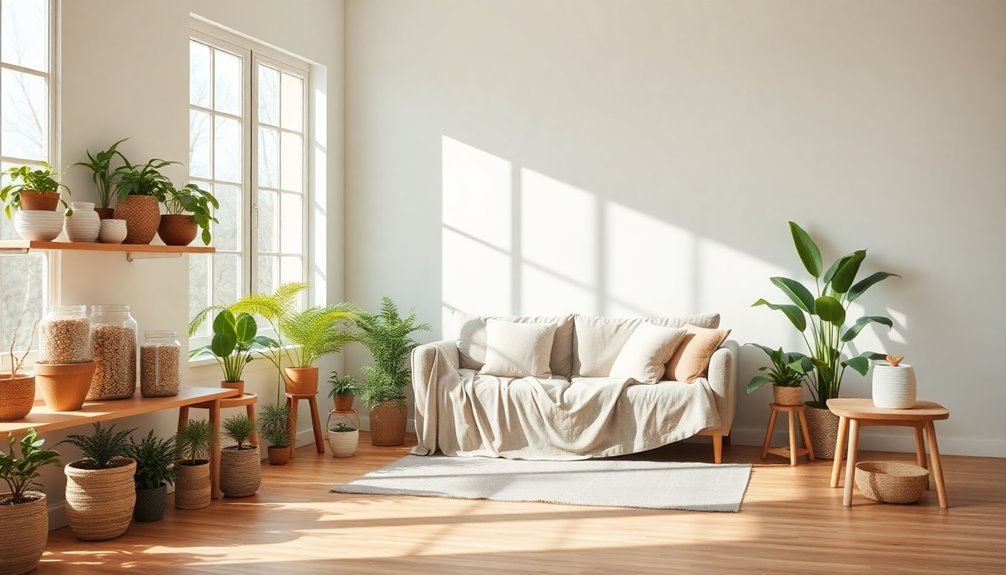Sustainable minimalism helps you simplify life while being eco-friendly. By reducing clutter and prioritizing mindful consumption, you can minimize waste and lower your carbon footprint. Start by decluttering items that no longer serve you, support environmentally conscious brands, and adopt practices like recycling and composting. Focus on experiences over possessions for lasting joy. With a commitment to your values, you'll foster deeper connections and find greater fulfillment. Discover more tips that make a meaningful impact.
Key Takeaways
- Embrace decluttering by letting go of items that no longer serve a purpose, fostering mental clarity and space.
- Prioritize intentional consumption by researching and supporting eco-friendly brands to reduce your carbon footprint.
- Implement recycling and composting practices to minimize waste and repurpose items effectively.
- Create a shopping list focused on essentials to curb impulse buying and maintain a clutter-free environment.
- Engage with community platforms to connect with others on the sustainable minimalist journey for motivation and support.
Understanding Sustainable Minimalism

Understanding Sustainable Minimalism starts with recognizing its core principles: living with fewer possessions while embracing eco-friendly practices.
This lifestyle emphasizes the importance of intentional consumption, helping you combat consumer exhaustion and reduce environmental impact. By focusing on sustainable minimalism, you can prioritize reducing waste and repurposing items, extending their life and minimizing landfill contributions.
As you declutter your space, you not only save money but also gain mental clarity and free time. This gradual change allows you to incorporate eco-friendly habits into your daily routine at a comfortable pace.
Ultimately, sustainable minimalism isn't just about having less; it's about living more mindfully, ensuring your lifestyle aligns with your values and positively impacts the environment. Additionally, embracing the art of decluttering can lead to a more organized and peaceful living space, enhancing your overall well-being.
The Benefits of Embracing Eco-Minimalism

Embracing eco-minimalism not only transforms your living space but also greatly benefits your overall well-being and the environment.
By adopting a minimalist and sustainable lifestyle, you can considerably reduce your carbon footprint through decreased consumption and waste. This shift promotes financial freedom, allowing you to save money and invest in high-quality, eco-friendly living products.
Decluttering your space leads to improved mental health, alleviating stress and anxiety tied to clutter. Prioritizing experiences over material possessions fosters deeper connections with others and enriches your sense of community.
Furthermore, engaging in mindful consumption empowers you to make informed choices that support sustainable practices. Regularly assessing and rotating items can also help maintain organization and prevent clutter buildup.
Ultimately, eco-minimalism enhances your life while protecting the planet for future generations.
Practical Steps to Start Your Eco-Minimalist Journey

Starting your eco-minimalist journey can feel overwhelming, but taking small, intentional steps can make all the difference.
Begin by decluttering your space—let go of things you no longer need, keeping only items that serve a purpose or bring you joy. This not only reduces stress but also promotes sustainable living.
Next, research and support environmentally friendly brands, and prioritize second-hand purchases to minimize waste.
Implement actionable steps like recycling, composting, and using energy-efficient appliances to lower your carbon footprint.
Create a shopping list to avoid impulse buys, ensuring each item aligns with your eco-minimalist values.
Regularly assess your belongings and habits to maintain a balance, fostering a lifestyle with a positive impact on the environment. Additionally, consider exploring renewable energy technologies to further enhance your sustainable lifestyle and reduce reliance on fossil fuels.
Mindful Consumption Habits

To embrace mindful consumption, start by evaluating the necessity of each item before you buy it. This simple practice not only curbs impulse purchases but also shifts your focus towards valuing experiences over material things. Additionally, adopting low carb diets can help streamline your eating choices, further emphasizing the importance of intentionality in all areas of your life.
Assessing Necessity Before Purchase
Before you reach for your wallet, consider whether the item is truly necessary for your life. Start by evaluating necessity: ask yourself how often you'll use it and if it genuinely adds value.
With over 300,000 items in the average American household, clutter can increase stress and diminish your ability to live more sustainably. Create a shopping list focused on essentials to avoid impulse buys that fill your shopping bags with things you don't need.
Reflect on the lifecycle and environmental impact of products, especially in industries like textiles, which are significant polluters. Limiting exposure to advertising can help you become a more sustainable minimalist, ensuring that your purchases align with your values and well-being. Additionally, consider the impact of digital literacy programs that can help you make informed choices about your purchases and reduce reliance on unnecessary items.
Prioritizing Experiences Over Things
While material possessions can provide temporary satisfaction, prioritizing experiences over things often leads to deeper and more lasting happiness. By focusing on experiences, you enhance emotional well-being and strengthen relationships, which are essential for a fulfilling life. Mindful consumption encourages evaluating what truly adds value to your life, reducing clutter and unnecessary purchases. Embracing the elegance of simplicity can transform your outlook on consumption and enrich your life.
| Experiences | Material Possessions |
|---|---|
| Lasting happiness | Temporary satisfaction |
| Stronger connections | Isolation |
| Eco-friendly choices | Resource-intensive waste |
Emphasizing experiences supports sustainable choices, allowing you to live simply and embrace a minimalist lifestyle. So, instead of accumulating items, invest in memories that enrich your life and contribute to a more sustainable world.
Eco-Friendly Decluttering Techniques

When you tackle the task of decluttering, embracing eco-friendly techniques can make a significant difference.
By adopting a sustainable approach, you not only simplify your living space but also contribute to a healthier planet.
Here are some effective techniques to take into account:
- Reuse and Repurpose: Transform old jars into storage or worn clothes into cleaning rags to minimize waste.
- Four-Box Method: Sort items into "Keep," "Donate," "Sell," and "Trash" to guarantee responsible disposal.
- Local Recycling: Research local donation centers or recycling facilities to understand the impact of your discarded items.
- One In, One Out: Maintain balance by evaluating new purchases to save money and prevent clutter accumulation.
Additionally, incorporating mindfulness practices can enhance your decluttering experience by promoting a clearer mindset.
Take action today and embrace minimalism and sustainability!
Building Community Connections for Sustainable Living

Embracing sustainable living goes beyond personal efforts; it thrives on the strength of community connections. By building community connections, you can engage in resource sharing through initiatives like crop exchanges and local repair cafes, which reduce waste and foster collaboration.
Participating in the Buy Nothing Challenge helps you focus on what you truly need while encouraging a culture of generosity. Joining local eco-focused groups offers support and inspiration, making it easier to adopt eco-minimalism practices.
Attend community events centered around sustainability, like clean-up drives or workshops, to strengthen bonds and promote environmental stewardship. Additionally, understanding shared assets and liabilities in your community can facilitate more effective resource sharing and collective decision-making.
Don't forget to utilize online platforms and social media to connect with like-minded individuals, fostering accountability and motivation in your sustainable minimalist journey.
Long-Term Commitment to Eco-Minimalism

A long-term commitment to eco-minimalism requires ongoing reflection and adaptation in your lifestyle choices.
To maintain this journey, consider these strategies:
- Regularly reassess your belongings and consumption habits to align with your eco-minimalist values.
- Build community with like-minded individuals for support and accountability in sustainable practices.
- Stay informed about environmental issues and innovations to make informed choices that enhance your commitment.
- Celebrate small victories in waste reduction and mindful consumption to reinforce positive habits.
Embrace a mindset of progress rather than perfection, as it helps manage eco-anxiety and promotes sustainable living. Additionally, consider the legalities of tiny houses as they can influence your choices regarding sustainable living spaces.
Your commitment won't only benefit you but also inspire others in your community to take similar steps.
Financial and Emotional Gains of Minimalist Living

While many people associate minimalism with giving up possessions, it also brings substantial financial and emotional rewards.
By focusing on what truly matters, you can achieve significant financial savings. Spending less on unnecessary items allows you to sell excess belongings for extra income. This shift not only eases your wallet but also supports your mental health, as a decluttered space reduces stress and anxiety.
Embracing sustainable practices means investing in quality, ethically produced items, which helps reduce your carbon footprint. Additionally, prioritizing experiences over possessions fosters emotional well-being, leading to greater life satisfaction. This journey often involves practicing self-reflection, which can help you better understand your values and desires.
With the time and resources you free up, you can engage in more meaningful activities that enhance your overall quality of life.
Frequently Asked Questions
What Are 10 Ways to Be More Sustainable?
To be more sustainable, start by reducing single-use plastics; switch to reusable bags, bottles, and containers.
Embrace second-hand shopping to cut down on waste.
Consider composting to manage organic waste effectively.
Support local businesses to promote ethical practices.
Prioritize energy-efficient appliances and habits, like using LED bulbs and unplugging devices.
You can also conserve water, grow your own food, use public transport, and educate others about sustainability to create a bigger impact.
What Is Sustainable Minimalism?
Sustainable minimalism is like decluttering your life while nurturing the planet.
It's a lifestyle that encourages you to live with less, focusing on what truly matters. By choosing quality over quantity, you reduce waste and lower your carbon footprint.
You're not just simplifying your space; you're making mindful choices that benefit both your well-being and the environment.
Embracing this approach can lead to mental clarity and a deeper connection with the world around you.
How to Live 100% Sustainable?
To live 100% sustainably, start by adopting a zero-waste lifestyle.
Focus on the three Rs: Reduce, Reuse, and Recycle. Incorporate energy-efficient appliances and consider renewable energy sources like solar panels to cut down your carbon footprint.
Be mindful of your purchases; choose second-hand items and those with minimal packaging.
Growing your own food or supporting local farms also helps.
Keep educating yourself and adjust your habits to align with eco-friendly principles.
What Is Eco Minimalism?
Imagine your home as a serene garden, where every plant serves a purpose.
Eco-minimalism is like that garden; it's about cultivating a lifestyle that merges minimalism and sustainability. You're making intentional choices to reduce waste, repurpose items, and support eco-friendly brands.
Conclusion
In embracing sustainable minimalism, you're not just simplifying your life; you're cultivating a more harmonious existence with the planet. By adopting mindful consumption habits and fostering community connections, you're gracefully steering toward a future that values both your well-being and that of the Earth. This journey may require commitment, but the financial and emotional rewards are well worth it. So, take a step back, breathe, and let the beauty of simplicity guide you toward a greener tomorrow.









